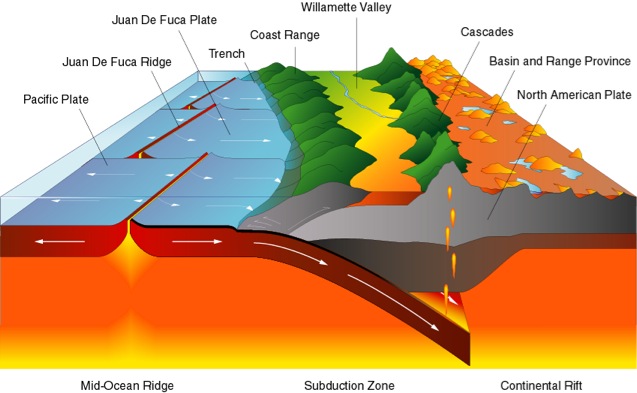

If you look at most plates, the different sides of the plates will move differently relative to the surrounding plates. Transform faults or transform boundaries also link different types of plate boundaries. Younger parts of the plate are warmer and higher than older parts. The Atlantic Ocean is one example where new sea floor is created. The magma eventually solidifies and new crust is created.Divergent plate boundaries mostly occur along oceans where new sea floors are created. Opposite sides of the fracture zone have different elevations because they formed by seafloor spreading at different times in the past, so they have had different amounts of time to cool and subside after forming at the spreading center. Along divergent boundaries, plates move apart and magma is forced to ooze out to fill up the gap. It no longer separates two plater and instead is within a single plate. A fracture zone is a former transform fault that now has no relative motion across it. Continuing outward from most transform faults is an oceanic fracture zone, which is a step in the elevation of the seafloor. The overall shape of the ridge mimics the edges of Africa and South America and so was largely inherited from the shape of the original rift that split the two continents apart. Transform faults are the third type of plate boundary, in which plates are only moving side by side and thus no new material is created or destroyed. The zigzag pattern of mid-ocean ridges reflects the alternation of spreading segments with transform faults. We first provide an overview of the geodynamic setting of the AGFZ with a special emphasis on the GF, its structure, seismic activity, and tsunamigenic potential. These transform faults link the different spreading segments. The Gloria Fault (GF) is a large transform segment of the Azores-Gibraltar fracture zone (AGFZ) marking the Eurasia-Nubia plate boundary in the NE Atlantic.

The offset you see that are oriented east-west are transform faults along which the two diverging plates simply slide past one another. Instead, two tectonic plates grind past each other. The spreading direction is parallel to the transform faults and perpendicular to the spreading segments. If we use the mid-ocean ridge in the south Atlantic Ocean as an example you’ll see that spreading occurs along north-south oriented ridges but the spreading is perpendicular to the ridges orientation the spreading is in the east-west direction. At transform boundaries, tectonic plates are not moving directly toward or directly away from each other. So what happens is that transform boundaries form to help accommodate some divergent motion. Spreading centers are these straight lines but they are breaking a curved surface. The zigzag pattern is basically what happens when you try to draw a straight line on a curved surface. Transform faults combine with seafloor spreading to form a zigzag pattern on the seafloor. In the oceans, transform faults are commonly associated with mid-ocean ridges. Transform boundaries exist along oceanic and continental plates. The transform fault boundaries connect spreading centers. In plate tectonics, a transform boundary (also known as transform fault boundary, transform plate boundary, transform plate margin or conservative plate. This causes earthquakes.What is a Transform Boundary? At transform boundaries, plates slip past each other horizontally along transform faults. No new crust is created or subducted, and no volcanoes form, but earthquakes occur along the fault. As a result, when the two plates finally succeed in moving with respect to one another, huge amounts of energy are released.

Lest you imagine a slippery, sliding motion, take note that the surfaces involved are exposed to huge amounts of stress and strain and are momentarily held in place. Transform boundaries are those that slide alongside one another. Another extreme formation due to the convergent boundary is the Mariana Trench, the deepest region on Earth. They formed when the Indian plate got subducted underneath the Eurasian plate. Convergent boundaries are responsible for producing the deepest and tallest structures on Earth.Īmong those that have formed due to convergent plate boundaries are K2 and Mount Everest, the tallest peaks in the world. Sometimes, the plate boundaries also experience buckling. That is, the denser plate gets subducted or goes underneath the less dense one. Other articles where transform plate boundary is discussed: Earth: The outer shell: type of plate boundary, the transform variety, two plates slide. When they collide, subduction usually takes place. Convergent boundaries are those that move towards one another. A transform boundary is area where the two plates scrape past each other horizontally, and no crust is created and destroyed, making it a conservative boundary.


 0 kommentar(er)
0 kommentar(er)
